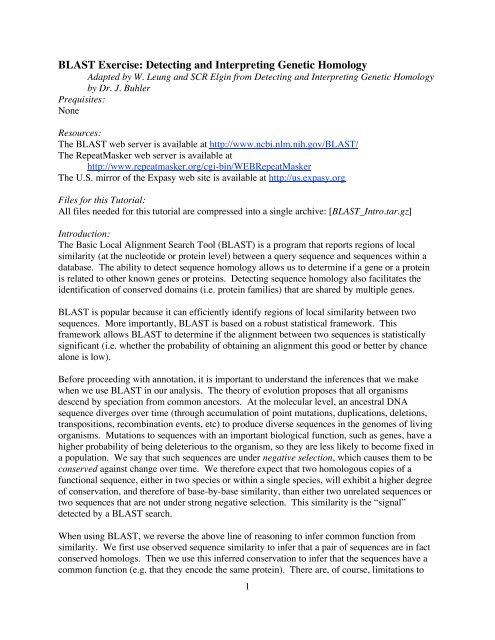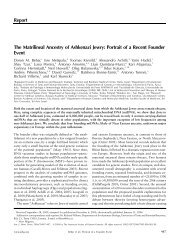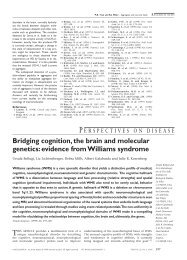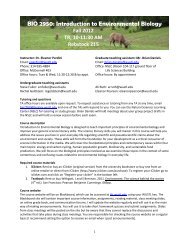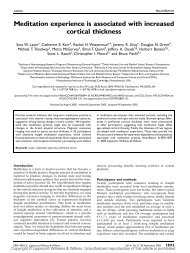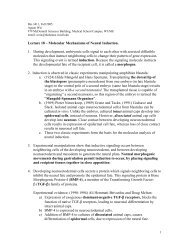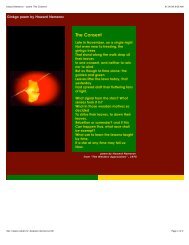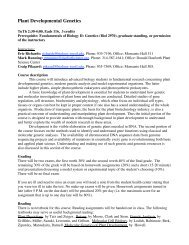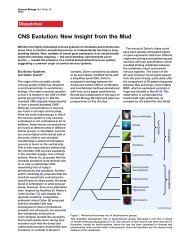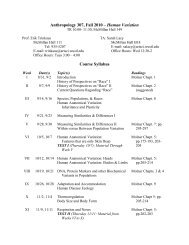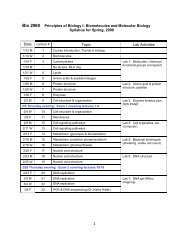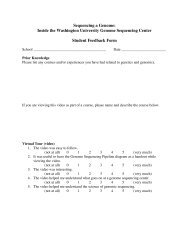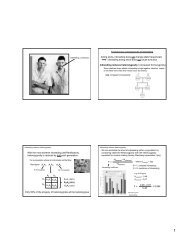BLAST Exercise: Detecting and Interpreting Genetic Homology
BLAST Exercise: Detecting and Interpreting Genetic Homology
BLAST Exercise: Detecting and Interpreting Genetic Homology
Create successful ePaper yourself
Turn your PDF publications into a flip-book with our unique Google optimized e-Paper software.
<strong>BLAST</strong> <strong>Exercise</strong>: <strong>Detecting</strong> <strong>and</strong> <strong>Interpreting</strong> <strong>Genetic</strong> <strong>Homology</strong><br />
Adapted by W. Leung <strong>and</strong> SCR Elgin from <strong>Detecting</strong> <strong>and</strong> <strong>Interpreting</strong> <strong>Genetic</strong> <strong>Homology</strong><br />
by Dr. J. Buhler<br />
Prequisites:<br />
None<br />
Resources:<br />
The <strong>BLAST</strong> web server is available at http://www.ncbi.nlm.nih.gov/<strong>BLAST</strong>/<br />
The RepeatMasker web server is available at<br />
http://www.repeatmasker.org/cgi-bin/WEBRepeatMasker<br />
The U.S. mirror of the Expasy web site is available at http://us.expasy.org<br />
Files for this Tutorial:<br />
All files needed for this tutorial are compressed into a single archive: [<strong>BLAST</strong>_Intro.tar.gz]<br />
Introduction:<br />
The Basic Local Alignment Search Tool (<strong>BLAST</strong>) is a program that reports regions of local<br />
similarity (at the nucleotide or protein level) between a query sequence <strong>and</strong> sequences within a<br />
database. The ability to detect sequence homology allows us to determine if a gene or a protein<br />
is related to other known genes or proteins. <strong>Detecting</strong> sequence homology also facilitates the<br />
identification of conserved domains (i.e. protein families) that are shared by multiple genes.<br />
<strong>BLAST</strong> is popular because it can efficiently identify regions of local similarity between two<br />
sequences. More importantly, <strong>BLAST</strong> is based on a robust statistical framework. This<br />
framework allows <strong>BLAST</strong> to determine if the alignment between two sequences is statistically<br />
significant (i.e. whether the probability of obtaining an alignment this good or better by chance<br />
alone is low).<br />
Before proceeding with annotation, it is important to underst<strong>and</strong> the inferences that we make<br />
when we use <strong>BLAST</strong> in our analysis. The theory of evolution proposes that all organisms<br />
descend by speciation from common ancestors. At the molecular level, an ancestral DNA<br />
sequence diverges over time (through accumulation of point mutations, duplications, deletions,<br />
transpositions, recombination events, etc) to produce diverse sequences in the genomes of living<br />
organisms. Mutations to sequences with an important biological function, such as genes, have a<br />
higher probability of being deleterious to the organism, so they are less likely to become fixed in<br />
a population. We say that such sequences are under negative selection, which causes them to be<br />
conserved against change over time. We therefore expect that two homologous copies of a<br />
functional sequence, either in two species or within a single species, will exhibit a higher degree<br />
of conservation, <strong>and</strong> therefore of base-by-base similarity, than either two unrelated sequences or<br />
two sequences that are not under strong negative selection. This similarity is the “signal”<br />
detected by a <strong>BLAST</strong> search.<br />
When using <strong>BLAST</strong>, we reverse the above line of reasoning to infer common function from<br />
similarity. We first use observed sequence similarity to infer that a pair of sequences are in fact<br />
conserved homologs. Then we use this inferred conservation to infer that the sequences have a<br />
common function (e.g. that they encode the same protein). There are, of course, limitations to<br />
1
this line of reasoning. For example, two unrelated sequences might appear similar purely by<br />
chance. Alternatively, a pair of sequences may be conserved homologs, but they may have<br />
diverged only recently (as in human <strong>and</strong> chimpanzee), so that conservation implies nothing about<br />
whether they are under negative selection. Finally, a pair of sequences may indeed be conserved<br />
homologs because of strong negative selection, yet have different functions. For example,<br />
consider the crystalline gene family, in which almost identical proteins serve both structural <strong>and</strong><br />
enzymatic roles, or the Adh1 <strong>and</strong> Adh2 genes of yeast, which are closely related but implement<br />
opposite enzymatic functions. While <strong>BLAST</strong> is a powerful tool for detecting similarity, we must<br />
also underst<strong>and</strong> its inherent limitations to properly interpret its results.<br />
Overview of the Annotation Process:<br />
The main goal of this lab is to identify interesting features (functional genes or non-functional<br />
pseudogenes) within a piece of the D. melanogaster genome. We will use the programs <strong>BLAST</strong><br />
<strong>and</strong> RepeatMasker to help us with the annotation. During the course of our investigation, we<br />
will also learn how to adjust some of the parameters in <strong>BLAST</strong> <strong>and</strong> in RepeatMasker to increase<br />
the sensitivity <strong>and</strong> specificity of our searches.<br />
Much of this lab consists of questions, which you should try to answer as you work through this<br />
tutorial. You should also make note of the exact <strong>BLAST</strong> <strong>and</strong> RepeatMasker parameters <strong>and</strong> the<br />
databases that you use for your searches, to ensure that your results are reproducible.<br />
You can find additional information on how to use <strong>BLAST</strong> at the NCBI website<br />
(http://www.ncbi.nlm.nih.gov/blast/producttable.shtml).<br />
Finding Interspersed Repeats:<br />
The file dmel_seq1.fasta contains a FASTA-formatted DNA sequence, which represents roughly<br />
4000 bases from chromosome X of D. melanogaster.<br />
Before we attempt to search for genes in our 4 kb sequence, we should first annotate its repetitive<br />
elements using RepeatMasker. RepeatMasker is a program that identifies transposable elements<br />
<strong>and</strong> low complexity repeats in anonymous DNA sequence. You can run the RepeatMasker<br />
analysis at the RepeatMasker web server. Alternatively, the RepeatMasker analysis of our<br />
sequence is available in the tutorial package (files within the DmelSeq1_RpM directory).<br />
Open the file lab1seq1.fna in a text editor (for example, most Macs would use TextEdit <strong>and</strong><br />
many PCs would use Notepad). Copy the sequence onto the clipboard. Go to the RepeatMasker<br />
web server <strong>and</strong> paste the sequence into the “Sequence” text box.<br />
2
Figure 1. RepeatMasker Web Server at http://www.repeatmasker.org/<br />
RepeatMasker works by comparing anonymous sequences against a database of known repetitive<br />
elements. Therefore, we should select the repeat database that best corresponds to the sequence<br />
we are annotating. After all, we would not want to waste time looking for Alu repeats in our fly<br />
sequence! Since our sequence is from a fruit fly, we will use the Drosophila repeat library. To<br />
change the repeat database, select the “DNA source” drop-down menu <strong>and</strong> change it to “Fruit fly<br />
(Drosophila melanogaster)” (Figure 1).<br />
By default, RepeatMasker also masks out simple repeats as well as low complexity DNA. Low<br />
complexity DNA may not have a highly repetitive structure, but these regions consist primarily<br />
of one or two out of the four possible nucleotides.<br />
Question 1: Why might it be a good idea to remove low-complexity DNA from a<br />
sequence before running blastn Why might it be a bad idea to do so before<br />
running blastx (Hint: consider proteins such as collagen that have highly<br />
regular sequences.)<br />
Figure 2. Turn off filters for low complexity repeats in RepeatMasker<br />
Since <strong>BLAST</strong> automatically filters low complexity regions when appropriate, we will tell<br />
RepeatMasker not to mask low complexity regions (Figure 2). Under “Advanced Options,”<br />
change “Repeat Options” to “Don’t mask simple repeats or low complexity DNA”. Note that the<br />
3
default behavior under “Return Format” is “tar file.” This option means that RepeatMasker will<br />
return the results of our search as a compressed archive file. Click “Submit Sequence”.<br />
Depending on how busy the server is, the analysis may take a while (Figure 3).<br />
Figure 3. Waiting for results from our RepeatMasker analysis<br />
Figure 4. Download results from the RepeatMasker web server<br />
The results page shows a summary of the RepeatMasker analysis. Click on the link “Masked<br />
sequence <strong>and</strong> matches in compressed format” (below the header) to download the archive file<br />
containing the results of the RepeatMasker analysis onto your computer (Figure 4).<br />
Typically, you can exp<strong>and</strong> the archive file simply by double-clicking the file. You can also<br />
exp<strong>and</strong> the archive by using gunzip <strong>and</strong> then untar the file. You can also use other programs that<br />
can process tar gzip files (ie. StuffIt Exp<strong>and</strong>er, Winzip). For this tutorial, you can exp<strong>and</strong> the<br />
archive file simply by double-clicking the file.<br />
Once you have exp<strong>and</strong>ed the archive file, you should have a folder with several useful files:<br />
o A copy of the original sequence with its repeats replaced by Ns, in a file ending with the<br />
extension “.masked”<br />
o A summary of the repetitive elements found in the sequence, in a file ending with “.tbl”<br />
o A detailed list of repetitive elements found, in a file ending with “.out”<br />
Question 2: How many repetitive elements does our sequence contain, <strong>and</strong> what<br />
are their types (Hint: examine the “.tbl” file.)<br />
4
In the next section, we will be working with another sequence, dmel_seq2.fasta. This sequence<br />
also comes from the X chromosome of D. melanogaster. Run RepeatMasker on this sequence<br />
using the same options as we have discussed above. Alternatively, the RepeatMasker analysis of<br />
our sequence is available in the tutorial package (files within the DmelSeq2_RpM directory)<br />
Question 3: What is your result Given the length of this sequence, would you<br />
expect the same result if it had come from a primate<br />
Translated Query vs. Protein Database (blastx): The Gene Hunter<br />
Following an initial annotation of repetitive elements found within our sequence<br />
(dmel_seq2.fasta), we would like to see if any part of our sequence matches any known genes.<br />
We will use <strong>BLAST</strong> to help us detect regions of our sequence that may be homologous to known<br />
genes.<br />
There are a few decisions we must make before proceeding with the <strong>BLAST</strong> search. We could<br />
look for matches to our sequence at either the DNA or the protein level, using any one of several<br />
databases. In deciding which comparison tool to use, we should consider a few factors:<br />
1. How sensitive will the comparison be Is it likely to find genes or other meaningful<br />
features in our sequence<br />
2. How specific will the matches returned by our tool be Will they cover the entire region<br />
or will they be confined to specific features of interest<br />
3. How good is the information associated with any matches we may find Will we be able<br />
to interpret those matches<br />
4. How long will the tool take to run<br />
Considering all these factors, a reasonable first step to characterize anonymous DNA sequence is<br />
to compare the DNA sequence to the Swissprot protein database (containing sequence data for<br />
characterized proteins) using blastx. In a blastx search, the query sequence (nucleotide) is<br />
translated into peptide sequences in all six reading frames <strong>and</strong> compared against a protein<br />
database. blastx is good at specifically identifying parts of a DNA sequence that codes for<br />
proteins similar to those in the protein database. Hence it should provide us with a relatively<br />
good picture of potential genes (true positives) in our sequence without a lot of clutter (false<br />
positives).<br />
If our blastx search against the Swissprot database fails to produce any significant matches, we<br />
could search our sequence against all proteins in the GenBank nonredundant (nr) protein<br />
database. The nr protein database consists of almost all real <strong>and</strong> hypothetical peptide sequences<br />
that have been submitted to GenBank. While this would increase our chances of seeing a match,<br />
the quality of the supplementary information associated with each protein in the nr database is<br />
much lower than for proteins in Swissprot.<br />
Note that there are also species-specific databases [i.e. FlyBase for fruit fly (Figure 5),<br />
WormBase for C. elegans, etc] available on the web. Using these species-specific databases can<br />
5
dramatically decrease the computational time needed for <strong>BLAST</strong> searches. For this tutorial,<br />
however, we will use the generic databases.<br />
Figure 5. The FlyBase web site (http://www.flybase.indiana.edu)<br />
Figure 6. A blastx search against the Swissprot database<br />
Open the file dmel_seq2.fasta <strong>and</strong> copy the sequence onto the clipboard. Then open a new<br />
browser window <strong>and</strong> navigate to the <strong>BLAST</strong> web server at NCBI<br />
(www.ncbi.nlm.nih.gov/<strong>BLAST</strong>/) <strong>and</strong> select blastx. Paste the contents of the clipboard into the<br />
search box. Under the “Choose database” drop-down menu, select “swissprot”. Click “<strong>BLAST</strong>!”<br />
(Figure 6).<br />
6
At the initial <strong>BLAST</strong> response page, click “Format!” <strong>and</strong> wait for the results (this may take a<br />
while). If you don’t want to go through these steps, the blastx output is also available in the<br />
tutorial package (the file blastxresults.html within the <strong>BLAST</strong>results directory).<br />
Question 4: How many blastx hits to distinct sequences were returned What are<br />
the best <strong>and</strong> worst E-values reported Are the matches with poor E-values<br />
consistent with those with better E-values<br />
When searching a large database, it is good practice to ignore matches with poor E-values. In<br />
principle, a match with an E-value less than 1 is a highly significant hit (since only 1 match is<br />
expected to be found by chance alone when searching the database). In practice, you should<br />
allow a large margin of safety in interpreting E-values. This is because the probabilistic model<br />
on which E-values are calculated relies on strong independence assumptions that may not<br />
accurately reflect the behavior of real biological sequences. As a rule of thumb, you should be<br />
suspicious of DNA sequence matches with E-values higher than about 1e-10 <strong>and</strong> extremely<br />
skeptical of such matches with E-values above 1e-5.<br />
Figure 7. Changing the E-value for the blastx search<br />
By default, <strong>BLAST</strong> reports matches with E-values that are less than or equal to 10. You can<br />
change this behavior by changing the Expect field (for example, to “1e-10”) under the “Options<br />
for advanced blasting” section (Figure 7).<br />
Question 5: Considering only the most reliable matches, what does <strong>BLAST</strong> say<br />
about the content of this sequence What caveats might you consider in<br />
interpreting these results<br />
7
<strong>Interpreting</strong> the blastx Output:<br />
Figure 8. Initial list of blastx hits to our sequence<br />
If you emulated our analysis thus far, you should now have strong blastx hits to the Swallow<br />
protein (Figure 8). However, remember that sequence similarity does not necessarily imply that<br />
our sequence contains the D. melanogaster version of the Swallow protein. We need to gather<br />
more evidence before deciding how to annotate our sequence.<br />
First, we need to find out more about the Swallow protein. A good place to start is the Swissprot<br />
database, which is h<strong>and</strong>-curated <strong>and</strong> has links to many other databases. To access the<br />
information for a protein, you need its Swissprot accession string, which is found in the last part<br />
of the GenBank accession number. In this case, we would like to examine the protein<br />
(SWA_DROME) that produces the most significant alignment (5e-148) with our sequence. A<br />
Swissprot accession string consists of an abbreviated gene name, followed by an abbreviation<br />
indicating which organism the particular protein in this entry came from. For example,<br />
SWA_DROME means that the abbreviated gene name is SWA <strong>and</strong> the source of the protein is<br />
DROsophila MElanogaster.<br />
Figure 9. The Expasy web site contains information on the sequences curated in the Swissprot database<br />
8
Figure 10. Results when searching for “Swallow” in the Expasy web site<br />
To access a Swissprot entry by its accession string, go to the Expasy web site<br />
(http://us.expasy.org) <strong>and</strong> enter the accession string in the search dialog box at the top of the<br />
page (Figure 9). You can also do a keyword search, such as “Swallow,” to find multiple entries<br />
(Figure 10). Alternatively, the record for SWA_DROME is also available in the tutorial package<br />
(file named SwissProtEntry.html).<br />
Figure 11. Swissprot entry for the Swallow Protein<br />
Question 6: Based on the Swissprot entry (Figure 10), what does Swallow do<br />
Does your blastx output match Swallow genes from more than one species, <strong>and</strong> if<br />
so, which species If you want to talk about this gene in your own work, whom<br />
should you cite as having discovered it (Hint: look at the GenBank record by<br />
clicking on the accession number, gi|xxx)<br />
Now that we know a bit more about the c<strong>and</strong>idate matches to our gene, let’s take a closer look at<br />
the blastx output. To produce an annotation, we need to verify that the query sequence really<br />
does contain the D. melanogaster Swallow gene. In particular, the match should be full-length,<br />
including all the coding exons of the gene. If exons are missing, this may indicate a pseudogene.<br />
To look at the alignment, go back to the blastx output page <strong>and</strong> click on the score.<br />
9
Question 7: What is the orientation of the Swallow gene relative to our query<br />
sequence<br />
Question 8: Look at all the matches to SWA_DROME in your blastx output. Is the<br />
entire protein matched (Hint: create a drawing of the blastx hits relative to the<br />
Swallow sequence. Check the individual alignments.) If not, which residues are<br />
missing Are there any regions of the protein that are aligned to multiple places<br />
in our query sequence [Hint: check the amino acid identities of the aligned<br />
fragments in the Graphical Representation of the blastx output (Figure 13).]<br />
Figure 12. Graphical Representation of alignments to our unknown sequence<br />
There is considerable confusion (missing residues <strong>and</strong> multiple hits to the same residues) in the<br />
<strong>BLAST</strong> alignments of the SWA_DROME protein with our putative coding sequence (Figure<br />
12). As an annotator, your job is to produce order from this chaos.<br />
Let’s start with the missing residues. Go back to the Swissprot entry for SWA_DROME <strong>and</strong><br />
find the part of the protein that is not represented by any of the <strong>BLAST</strong> alignments of<br />
SWA_DROME with our sequence, as shown by your analysis for Question 8.<br />
Question 9: Which amino acids predominate in the missing region Given that<br />
blastx likes to mask low-complexity sequence in the query before a search, do you<br />
have a reasonable explanation for why this part of the protein is missing How<br />
can you prove your hypothesis (Hint: repeat your blastx search with the lowcomplexity<br />
filter turned off; compare maps showing HSP’s relative to your query<br />
sequence.)<br />
10
Figure 13. blastx with repeat-masked query sequence<br />
Around amino acid 190 of the protein (subject) sequence, you will see a string of X’s<br />
representing masked residues (Figure 13) in the query. <strong>BLAST</strong> apparently decided that the<br />
protein in the region, rich in serine/asparagines, should be marked as low-complexity. Aligning<br />
a residue to an X yields a negative score.<br />
Question 10: Given blastx seems happy enough to include masked residues in its<br />
alignments, why didn’t it include residues 78-90 of the protein [Hint: look at the<br />
frames (specified in the heading) of the matches ending at 77 <strong>and</strong> beginning at 91.<br />
What happens if you add negative-scoring residue pairs to the end of an<br />
alignment]<br />
Now we need to deal with the duplicated matches. The best way to make sense of the output is<br />
to sketch out the relative positions of all the matches to SWA_DROME in the query on a piece<br />
of paper (see Figure 14). Note the residues of the SWA_DROME protein that match with each<br />
part of the query.<br />
Question 11: How many distinct features (i.e. genes or pseudogenes) seem to be<br />
present at this locus Which one seems most likely to be the true Swallow gene<br />
What might the other matches be, <strong>and</strong> what biological mechanisms might have<br />
produced them<br />
Further Exploration Using blastn:<br />
To make further progress in determining the correct annotation for our sequence, we will try to<br />
obtain additional evidence at the nucleotide level, specifically looking at Drosophila mRNAs.<br />
In order to detect homology at the nucleotide level, we will use blastn instead of blastx. As was<br />
the case for the blastx search, there are some decisions we must make before we perform the<br />
search. For example, our choices of a database against which to search our query include the<br />
GenBank nonredundant nucleotide database (also known as nr), or one of the EST databases.<br />
11
ESTs are pretty noisy <strong>and</strong> do not come with easily accessible annotations, so we will use the<br />
nucleotide nr database.<br />
Figure 14. blastn search againt the nr database<br />
To do the blastn search, go back to the <strong>BLAST</strong> page at (http://www.ncbi.nlm.nih.gov/<strong>BLAST</strong>)<br />
<strong>and</strong> select Nucleotide-nucleotide <strong>BLAST</strong> (blastn). In the “choose database” menu, make sure<br />
that “nr” is selected. Open the file containing our sequence, copy it onto the clipboard, <strong>and</strong> paste<br />
it into the search box (Figure 14). Click “<strong>BLAST</strong>!” then click “Format!” Alternatively, the<br />
blastn output is also available in the tutorial package (see the file blastnResults.html within the<br />
<strong>BLAST</strong>results directory).<br />
Question 12: Had your query contained a repetitive element such as a<br />
transposon, what would have happened had you forgotten to repeat-mask the<br />
query before running it<br />
Figure 15. Refseq matches have accession numbers that begins with “ref”<br />
The sequences in the GenBank nr database come from numerous sources, including genomic<br />
contigs from genome sequencing projects <strong>and</strong> mRNAs/cDNAs. A particular useful class of<br />
12
mRNA entries is the NCBI Refseqs, which come from a curated database of full-length mRNAs<br />
for various genes. You can find out more information about the Refseq database at<br />
http://www.ncbi.nlm.nih.gov/RefSeq/. Refseq matches can be easily recognized in the <strong>BLAST</strong><br />
output because their accession numbers always start with “ref” (Figure 15).<br />
Question 13: What is the best Refseq match to the query How good is the match<br />
to what you think is the true Swallow gene (Hint: Create a map showing blastn<br />
hits to the query sequence as you did for Question 9.) Based on this alignment,<br />
how many exons does the gene have, <strong>and</strong> roughly where do the introns occur<br />
Question 14: How well does the Refseq match the other part of the query Can<br />
you see matches that were not visible at the protein level Why might this be<br />
The main question at this point is what is the other set of matches outside the region that we<br />
believe to be the D. melanogaster Swallow gene Do these matches reveal a real gene or<br />
pseudogene Pseudogenes are rare in Drosophila compared to mammals, but they are not<br />
unknown.<br />
There are at least two types of mutation that strongly suggest that a putative match to a gene<br />
might be a pseudogene. One is a stop codon that truncates the protein prematurely in the middle<br />
of a coding exon. You can see such internal stop codons in a blastx alignment as star (“*”)<br />
characters. Another diagnostic mutation is a gap in the middle of an exon that would cause a<br />
frameshift. Typically, this type of gap is visible only at the DNA level, since a frameshift will<br />
quickly terminate a blastx alignment.<br />
Question 15: Keeping in mind the exon boundaries you inferred above, can you<br />
find evidence of premature stop codons <strong>and</strong>/or frameshift-inducing gaps that<br />
would cause you to diagnose a pseudogene adjacent to the Swallow gene<br />
Describe any evidence you find.<br />
Summary:<br />
Question 16: Based on all the evidence gathered in this lab, how would you<br />
annotate the query sequence What uncertainties remain Compose a short (a<br />
few sentences) paragraph that you could add to an annotation database<br />
summarizing your findings.<br />
Last Update: 06/15/2006<br />
13


